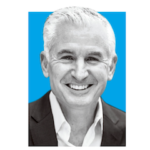
As speakers and authors with hot-off-the-press books on creativity, Todd Henry and Keith Sawyer, Ph.D., have their own approaches to innovation. But they’re in sync on many things when it comes to creativity and execution, including the importance of collaboration — which is what they’ll be doing for the first time as a team at PCMA’s Convene Live program on July 28-30, in Ottawa.
During two four-hour workshops, Henry and Sawyer will work alongside meeting-professional participants to help them tap into and unleash their creative potential. Henry will kick things off with a session drawing from his consulting experience and popular Accidental Creative podcast, which will lay the groundwork for creative exploration. Sawyer will pick it up the next day, with findings from his extensive research on the creative process and exercises to help participants translate their ideas into plans for more inspired and productive events.
Convene recently spoke to Henry and Sawyer about the often winding road from idea to execution, how to smooth out the journey — and what Convene Live participants can expect from them come July.

TODD HENRY
‘Creativity Doesn’t Mean Art’
It’s not an autobiography, but the title of Henry’s first book — The Accidental Creative: How to Be Brilliant at a Moment’s Notice, published in 2011 — speaks to his “thoroughly unpredictable career path.” After studying marketing, Henry worked in the music business. He wound up as the creative director at a nonprofit, and when he networked with creative directors at other agencies, he asked how they kept their teams “engaged, fresh, motivated, and healthy. They looked at me like I was crazy,” he said. Their response? “‘We just burn through them, and then we bring in a fresh crop. There’s always somebody waiting to take their job.’”
That didn’t sit right with Henry, so he started doing research and experimenting to see what keeps creativity alive — “distilling all of that down,” he said, “into a set of practices.” Once Henry started sharing those practices, he began getting requests from companies to consult with them on idea generation, marketing strategy, and the creative process. “Really, and I say this without any irony, but I started the Accidental Creative company accidentally,” he said. “I created a podcast called the Accidental Creative, and within really a couple of years I was spending most of my time working with companies, helping them generate ideas.”
Henry’s new book —to be released in July — also speaks to his life’s work. Die Empty: Don’t Go to Your Grave With Your Best Work Inside of You is designed to help people avoid falling “prey to forces that lead to mediocrity,” he said. “Instead, make sure that you’re being [intentional] about how you spend your day, your focus, your time, and your energy.”
How do you define creativity?
If you have to solve problems on a daily basis — meaning taking data, lots of things in your environment, and weaving them together to form some kind of elegant solution — that is the act of creativity. Anyone who works with their mind and solves problems has to do that every single day. You have to do it on demand. You have to do it underpressure.
I want to help people understand that creativity doesn’t mean art. It doesn’t mean design. It encompasses those things, but it’s much more expansive than that. If you have to solve problems every day, you are [under] the exact same pressures as the designer who sits in front of a screen and has to visually design something. It’s just that you may not be equipped to deal with them as effectively, because you weren’t steeped in that creative culture in your training or in your experiences prior to this. There are specific things you can do to help you have better solutions to those problems and have them when you need them most.
What are those specific things?
I go into the elements of rhythm that we can build into our life, which basically means building an infrastructure, a set of practices that positions you to have ideas more consistently when you need them. There are five areas where I’ve prescribed very specific practices.
The first is focus — how you define the problems that you’re trying to solve. This is really important, because many people get carried along by their work [without] stopping to define their work consistently.
Second, relationships are critical, because when we get into problem-solving mode or creative mode, we tend to isolate ourselves because we think, “I have to knuckle down and make it happen.” But that’s really the worst thing we can do, because innovation is typically a collective grasp, [and we need to] stay connected especially during those busy times.
The third element is energy, [which is] all about how we manage our ability to bring the fullness of who we are to what we do. We tend to think that if we have the time available for something that we can do it. So we stack meeting after meeting after meeting, but we’re not cognizant of how each of those meetings or obligations requires something of us. If we’re not conscious about managing our energy, we’ll have absolutely nothing left to offer.
I talk about some practices related to energy management that make us effective. For example, pruning — regularly going through your project load and asking, which of these things are really good ideas that I need to remove because I simply can’t bear this entire load right now? That’s a hard thing to do and we don’t like to do it, but we can’t do everything and be effective at the same time.
[pullquote class=”pulllright”]If you want to be brilliant, you have to get as far upstream from the moment that you need a brilliant idea.[/pullquote]The fourth element is stimuli. These are all the things we put in our head that form our creative process — that challenge us, help us see the world in new ways, and inspire us. Many people are less than purposeful about the kinds of things they fill their mind with — I give them practices to help them identify beneficial stimulus and fill their lives with it.
The final element is hours. Hours are all about where we put our time, but many of us default to efficiency versus effectiveness — meaning we would rather crank through a bunch of work because it makes us feel like we’re getting something done, crank through emails, crank through phone calls. We don’t do the things that may feel really inefficient in the moment, but might actually make us more effective in the long term. We don’t sit around trying to come up with ideas for our most important project, because in the moment that doesn’t feel efficient. You know, we might sit around for an hour doing — and I’ll teach [attendees] exercises related to this — some exercises to come up with ideas for the work that we’re doing. It feels inefficient, yet we may come up with an idea that yields five years’ worth of value for our company. That’ s pretty effective. We need efficiency and effectiveness. We just can’t default to one at the expense of the other.
How do these practices put you in a more creative state?
If you want to be brilliant and want to be noticed, you have to get as far upstream from the moment that you need a brilliant idea. The way you do that is by building these practices that prepare you for the moment when the client comes to you and says, “I need something and I need it in three hours” — and you have to come up with this great idea. If you’ve been managing your focus, you’ve defined your problems effectively, you’ve got inspiring relationships to draw from, you’ve been managing your energy so that you don’t have too many things on your plate at once, you’ve been filling your head with inspiring stimuli, and you’ve been thinking about your hours in terms of effectiveness and not just efficiency — [then] you’re going to be way better positioned to generate an idea in the moment than if you’ve been letting obligations bounce off you and you’re drifting through your life.
What kind of stimuli would you recommend to meeting professionals?
I think the ability to handle complex problems, complex situations, to be able to plan complex events — if you have a varied experience base to draw from, that’s going to be nothing but an asset. What kinds of problems are you studying, what kinds of things are you looking at from outside of your industry? Because, most of the time, the next great breakthrough in your industry is not going to come from inside your industry — it’s going to come from outside your industry.

KEITH SAWYER, PH.D.
‘I Think Everybody Is Creative’
The most significant finding to emerge from research about creativity, according to Sawyer, a professor of education, psychology, and business at Washington University, is that it doesn’t come from a single, big flash of insight. Rather, the creative process happens via many small ideas throughout the day. “When you see these tiny ideas that even exceptional creators have, you see that it’s not so mysterious,” Sawyer said. “It only seems surprising and amazing because of the process they’ve gone through that allows them to put together these small ideas over time to result in something big and impressive at the end.”
There isn’t a straight line that goes from “brilliant insight to successful creative outcome,” he said. The process wanders — hence the title of Sawyer’s new book, Zig Zag: The Surprising Path to Greater Creativity. “The idea you have at the beginning,” he said, “almost never turns out to be what you generate at the end. People who are engaged in creativity on a daily basis understand that and they welcome it, and they have figured out techniques to help them move more quickly and more successfully through that zig-zag process. It’s really a matter of just learning what those habits are that will get you down the path.”
Sawyer’s career path has taken its own twists and turns. Shortly after graduating from MIT with a degree in computer science in 1982, Sawyer bumped into a few fellow MIT students on the flight he was taking to California for an interview at Hewlett Packard. “It turns out they had just started a videogame company,” he said, “and they asked me to interview with them when I got back home in Boston — so I kind of stumbled into the videogame business.” He worked at that for a few years before he “stumbled into a management-consulting position.” At 30, Sawyer decided to go back to graduate school to “do research on creativity, get a Ph.D., and become a professor.”
Meeting planners may not necessarily see themselves as creative types, but more like logistics experts. How might you convince them otherwise?
I think everybody is creative, frankly, and everybody has the mental capabilities that the most exceptional creators use. So it’s really a matter of tapping into creative potential that we all have already. There really isn’t a strong correlation between a particular kind of personality trait and creativity. Exceptional creators are all over the spectrum in terms of personalities — extroverted, introverted, more visual, more verbal.
[Planners are] creating an experience for the people in attendance — that involves so many different factors. It seems to me you have to know a lot about the people who are going to attend — their fears and concerns, and what their current level of knowledge is. There maybe different types of people there with competing levels and interests. So putting all that together and then coming up with a program and a list of speakers and activities that actually satisfy those needs and those concerns — to me, that sounds like a fascinating creative challenge.
With just about any creative profession, there is a large part of the job that is tedious and boring. Even if you’re a fine-art painter, you’ve got to buy canvas and build the frame out of pieces of wood and stretch the canvas on the frame. And then you’ve got to prep it before you can even start painting on it. I believe that’s my role in Ottawa — to talk about how to translate creativity into successful execution.
How does collaboration factor into that process?
In my research, I found that collaboration is almost always involved in the creative process. With meeting planners, it seems like in many cases you’re balancing a lot of different interests, so you might need input from many different people in the organization. I mean, how do you formulate the challenge of creating this experience? You won’t be able to do that successfully if you’re not gathering information from all of the stakeholders.
What do you want Convene Live participants to get out of your session?
The most important thing is to realize, number one, that you have the potential to be creative on a daily basis. Number two, [I will provide] some very practical techniques and exercises that can show you how to better realize that creative potential. My goal is to demystify this creative process.
The first step is asking good questions. A lot of us think that creativity is about coming up with the brilliant, insightful solution — but exceptional creators know that it’s almost more important to ask the right questions, to formulate the problem in a certain way. I have exercises that slow people down and encourage them to step back from the assumptions they may not even realize they have. When you question those assumptions, that’s when you start to think of better and more promising ways to formulate the problem.
It’s a way of shifting your mindset. Another set of techniques [has to do with] being aware of the world around you. There are so many cases throughout history where great new ideas came from just paying attention to what’s going on around you — those accidental discoveries, like penicillin. It’s that sort of being open to unexpected things that happen around you that’s so often associated with creative people.




